
Illustrating the ocean is difficult, this is because
it never sits still long enough for you actually draw or paint, it is
always in motion, and ever changing. This tutorial
deals with just one aspect of the sea, and that is when you are standing
on the shore with the sun on or near the horizon and the waves are breaking.
Often, you will almost seem
to see through the waves, they are not quite
transparent, and the effect of the sun lightens areas of the wave making
them beautiful to watch. Today, I'm going to show how to duplicate that
effect when you create your own
illustrations of the sea. PSP has a few nifty
tools that speed up this process considerably.
First start off by opening a new file, make it
twice as wide as it is long to give your final picture a "Snapshot" look.
In this case, The new file was created at 800
pixels wide by 400 pixels high with a 72 PPI resolution, and a white
background as I wanted to use the image online
only.
Choose your Line drawing tool and in the
tool
options section, choose Bezier Curved, and Stroked lines,
give it a width of four pixels, and check the "Anti-alias" box.
The first lines we are going to draw are the rough shapes of the waves,
I set the foreground color to grey so the lines would be grey. Overlap
the bezier lines like this:

Next you are going to fill in the main ocean
colors... You can start by choosing a medium or dark green...
select the areas you want to fill with the magic
wand, holding down the shift key to select multiple areas.
Next select your fill tool, another words
the paint bucket on the left side menu... right click for the tools option
menu. On the tool options menu for your
fill tool, choose Solid color, and Darken,from
the drop down menus
and set your Opacity to 100%. Click anywhere
in the selected area to fill... your pic should look like this now:
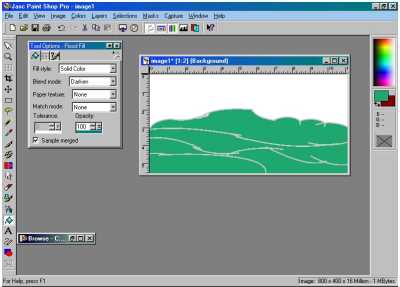
Next your are going to put in the the deep water,
and the areas where the water sections are dense...
Choose Layer: New Raster Layer to create
another working layer so you don't mess up the seagreen layer.
By creating another area to work on in the illustration
you can mess up and you won't lose all your work.
On the new layer, choose the airbrush tool,
(The Spray Paint can on the left side menu) set your forgeound color
to black, deep navy blue, or a dark purple. In
the tool:option menu set the Opacity, and Step of
the airbrush to
25% each (25). Then paint in the deepwater
areas by repeatedly airbrushing segments of canvas where the deep
waters will be.... You can experiment around
a bit, and try different colors out, to see how the image will
turn out different...
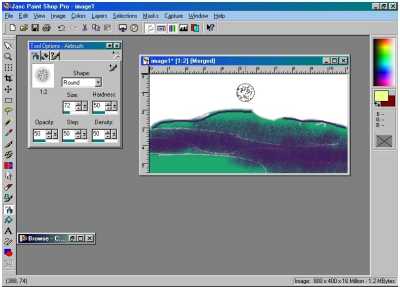
When you are done merge the layers together using
Layer:Merge,
and choose the merge visible option...
Now are you ready to put in highlights? Good!
Create a new raster layer. Choose the lasso off your menu
and lasso areas of your picture where the sun will shine through, or where
the water will be shallow and more translucent... Pick a light lemon
yellow foreground color and then choose your airbrush tool. Keeping
the Opacity and Step size the same, reduce
the size of the brush and paint in the brighter areas. When you
are satisfied, merge your layers together and your illustration
should look now look like this
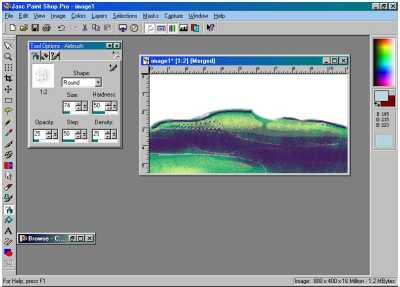 :
:
Now it's time to add the foam and whitecaps...
ready?
Choose a very light blue or grey foreground color.
Keeping your airbrush tool on a tight leash, with a small
brush diameter. In the airbrush tool:option
menu you can increase the Opacity and Step to 50 %
or even more
for the first few strokes... All you want to
do is airbrush in the lines you drew first resembling the shapes
of the
waves, then increase the diameter
of the brush, and decrease the Step and Opacity
to
less than 20%, go over
the lines you just drew again, and further wherever
you want to put spray or your wave crest, run the airbrush over
these areas. When you are done, you'll be doing
real good if your illustration looks like this:
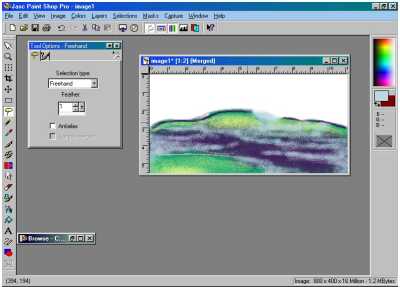
Ok... Now for just a couple more steps and you
will be all set. You want to blur the image to blend the pixels
together some. Choose Image:Blur from
the menu.... Maybe once more just to get the picture good and blurry...
Then you are going to take one more major step,
after that it's all touch up. You are going to apply a hot wax coat
to your illustration. Here's how. On the top
file menu, choose Image:Filter Browser and choose Hot Wax Coating.
Wow! Now we are getting close... Go ahead, experiment
with all the filters to see what they can do for you...
This is starting to look like a real ocean...
From here, we go to final touchups...
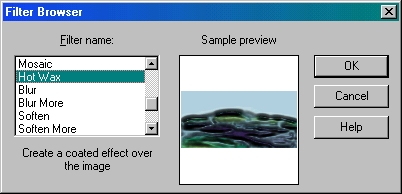

Choose Image:Blur once or twice more to
get rid of the grainy effect of the hot wax coating and choose your
Airbrush to finish the job. You want to
pick a bright off-white color as you are going to now add in the wave crest
and selected areas will have sea spray as well.
With your air brush diameter small, and your airbrush Opacity
set
to 50 or 75 % and your airbrush
Density set to 75% paint the white foam crest of the wave right
underneath the
sea horizon line, paint in any other areas where
the foam is so thick as to obscure the ocean at this time as well.
Now set the Airbrush Opacity and Density
to 25 % keeping the brush small add sea spray in selected
areas around the foam and crest where the sea is especially violent. If
anything looks odd in the illustration use the Touchup tool
on the left side of your menu (The little hand
symbol...) The touchup tool allows you quite a variety of blending
options to experiment with, and with your
eyes, you can any fix any obvious inconsistencies in the illustration.
Play around, experiment a bit. With just a bit
of practice you too, can be creating realistic seascapes in ten minutes
or less... Here is what the final illustration
looked like after adding the wave crests, touching up the sea spray, and
blurring the image one last time. Note: this is actually two 400x800 images
placed end to end...

Thanks for your time today. You can look forward
to seeing other tutorials on oceans painting before too long
featuring the varied effects of ocean temperature,
sunlight, glow and reflections, along with another tutorial on how
to paint nearly transparent water flowing over
rocks... (Great for rocky seashores and high mountain streams...)
Bibliography:
Robinson, E. John. The Seascape Painters Problem Book
New YorkWatson Guptil Publications, 1976.
Jasc Software. Jasc Paint Shop Pro Version 6.0 User's Guide
Jasc Software, Inc. 1999.
Copyright 2001, all rights reserved, Dirk T. Collins
res04tzu@gte.net
